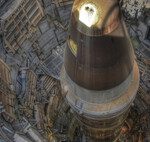About 95% of iPhones are still produced at the Zhengzhou factory in China. Since 2016 the transfer has accelerated, although the Indian bureaucracy and technological backwardness continue to play an important role. But according to many analysts, the India of today resembles the China of 20 years ago.
New Delhi () – Hundreds of people attended the inauguration of the second new Apple store yesterday in New Delhi. A few days before, on April 18, one had been opened in Bombay, considered the financial capital of India, while on Wednesday, between one inauguration and another, he met with the Indian Prime Minister, Narendra Modi Tim Cook, the CEO of the Cupertino-based company and successor to Steve Jobs. “We share a vision of the positive impact technology can have on India’s future: from education and developers to manufacturing and the environment, we are committed to growing and investing across the country,” Cook tweeted after the meeting.
The opening of the two new stores is all about diversifying supply chains and moving manufacturing out of China, an activity called decoupling, “decoupling”. It began to make itself known and explicit with the “trade war” proposed by the Trump presidency in 2016, and then accelerated due to China’s “zero Covid” policy, which has slowed global trade for months.
As a huge market – 1.4 billion people – with a rapidly growing middle class, many believe that India could play the same role for Apple as China did 20 years ago: 44% of the population is between 18 and 25 years old, and minimum wages are on average one-third to one-half of those in China. At present, the diffusion of the iPhone in India is only 46.5% (compared to 81.6% in the US) and it generates a revenue of 6,000 million dollars, that is, less than 2% of the total. The Indian population has so far preferred low-cost smartphones produced by China’s Xiaomi or South Korea’s Samsung, spending an average of $224, according to estimates by the International Data Corporation, a company that collects and analyzes information relevant to technology markets. However, this represents an increase in mobile phone spending of 18% in one year, so, according to economists, even if Apple’s cheapest model currently costs almost double, with the expected increase in the average income of the India, the demand for high-end technology products will also grow.
Already at the end of September last year, Apple had announced that it wanted to produce part of the iPhone 14 in India, a percentage that, according to forecasts by the American bank JP Morgan, could go from 5-7% today to 25% in 2025 and , according to other estimates, to 40 or 50% in 2027. Foxconn, Apple’s main partner for the assembly of its products, has been manufacturing iPhones in Chennai, in Tamil Nadu, since 2017 and at the end of February announced that it would triple the number of workers up to a total of 100,000 and would increase production to 20 million units. Indiscretions spread in recent months ensure that the Taiwanese company plans to open another center in Bengaluru, Karnataka, at a cost of 664 million euros and employing the same number of workers. Foxconn’s expansion would deal a major blow to Narendra Modi’s government, which has long wanted to narrow the technology gap with China and attract Western investors who, for political reasons, are finding it increasingly difficult in Beijing.
However, experts stress that the transfer of production from China to India will not be an easy process, let alone a quick one. Tim Cook himself had flown to Beijing last month, signaling his intention to keep some focus on China, which generates 20% of Apple’s annual revenue and buys seven times as many smartphones as India.
Although in the Western imagination Chinese products are still considered low quality, the truth is that the Dragon has made giant strides in the last two decades to develop technological products that are difficult to replicate elsewhere. Today, more than 95% of iPhones are still produced at the Zhengzhou factory (called “iPhone City”), which employs 300,000 workers.
An article from Financial Times he had documented the difficulties encountered in India by engineers Apple sent from California and China. In a Tamil Nadu factory run by the Indian conglomerate Tata, for example, only one in two components coming off the production line can be sent to Foxconn for assembly. In addition, there is not the same level of cross-coordination within the Indian government as in China, which has helped create a fast and efficient production machine. On the contrary, the Indian bureaucracy is considered a major obstacle. Apple engineers visiting Tamil Nadu found they had to commute four hours a day to reach the Foxconn factory in Chennai, often with slow or no Wi-Fi connections.
These difficulties have also been highlighted in a article of the People’s Dailythe newspaper of the Chinese Communist Party, which believes that the activities of decoupling they will turn against the United States in the long run. Among other things, because “if the US increases its blockade of Chinese high-tech, Chinese consumers will certainly not be as loyal ‘Apple fans’ as they have been in the past.”
“INDIAN MANDALA” IS THE NEWSLETTER OF ASIAN NEWS DEDICATED TO INDIA
WOULD YOU LIKE TO RECEIVE IT EVERY FRIDAY IN YOUR EMAIL? SUBSCRIBE TO THE NEWSLETTER AT THIS LINK.











